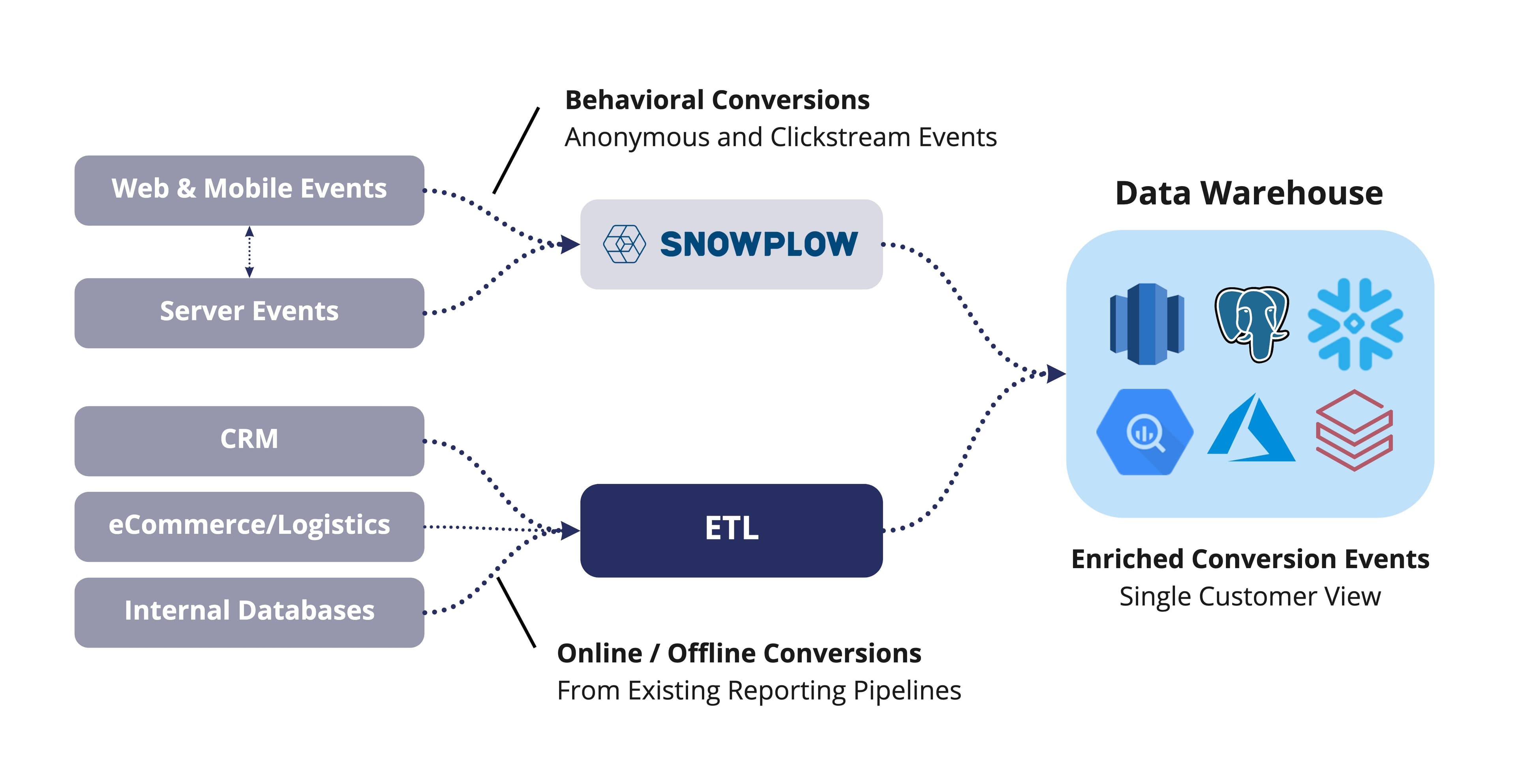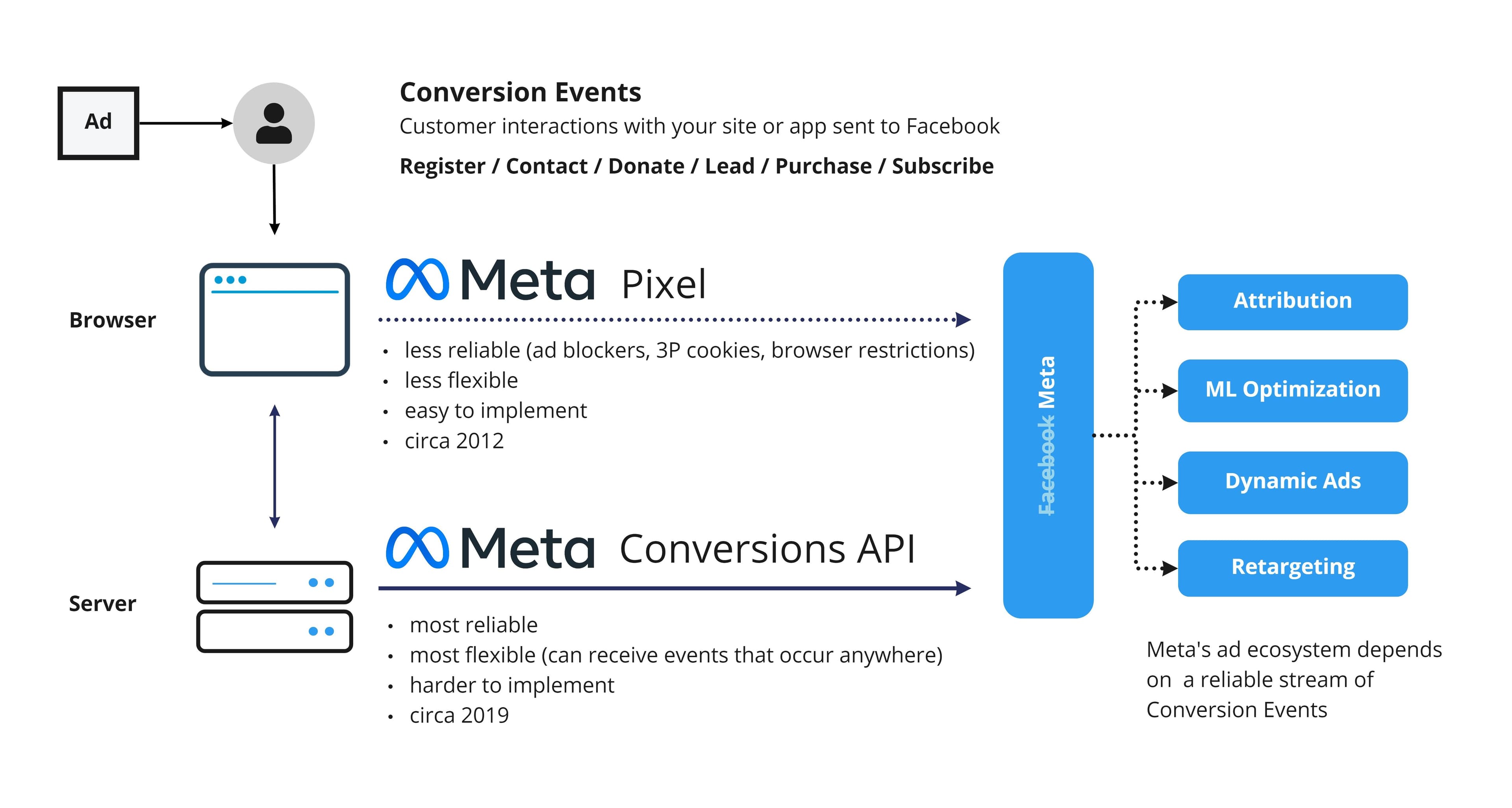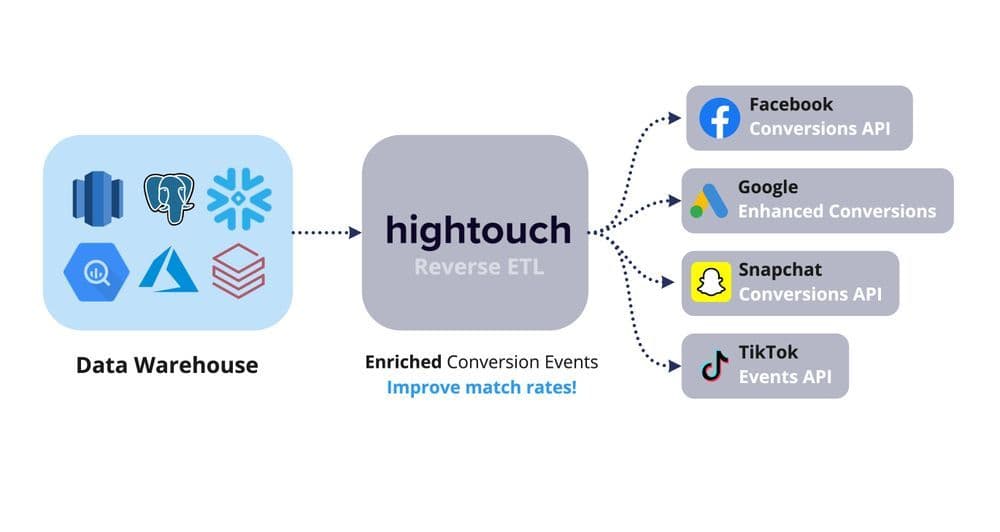Changes in consumer privacy on the internet have dramatically altered the digital advertising ecosystem over the past several years, with even more sweeping changes on the near horizon. Conversion tracking (key events captured when a user interacts with your product) does not only provide essential information for ad networks, but it’s also extremely vulnerable to new browser restrictions and ad blockers.
In response, all of the major networks are rolling out “Conversion APIs” as a way to share events server-side, which makes them much more powerful because the integration is extremely reliable and unencumbered by browser restrictions. The downside to Conversion APIs (e.g. server-side APIs), is that they’re much more time-intensive to set up than simply embedding a web pixel into your website. Fortunately, many conversion events are readily available in your data warehouse. When combined with Reverse ETL, you can vastly reduce the level of effort to begin supporting these advertising endpoints in the AdTech context.
In this article we’ll cover the following:
- What is a Facebook Pixel?
- The Rise of Conversion APIs
- What is a Conversion API
- What’s the Difference Between a Conversion API and a Facebook Pixel?
- Getting Started with Conversion APIs
- Storing Conversion Events in the Data Warehouse
- Advantages of a Single Customer View
- Real-Life Examples
- Getting Started with Conversion APIs using Reverse ETL
What Is a Facebook Pixel?
In the past, the easiest way to send data to your ad platforms was to simply leverage a web pixel or code snippet and place it on top of your website, product, or app to capture important user event data through third-party cookies. The Facebook pixel (now called a Meta Pixel) introduced in 2012, is probably the most common. The standard Facebook pixel offers 17 different types of events:
- Add Payment Info
- Add to Cart
- Add to Wishlist
- Complete Registration
- Contact
- Customize Product
- Donate
- Find Location
- Initiate checkout
- Lead
- Purchase
- Schedule
- Search
- Start Trial
- Submit Application
- Subscribe
- View Content
For the most part, Facebook Pixels (or any code snippets) are usually managed through Google Tag Manager. Google Tag Manager lets you create tags for your different events (e.g. product page viewed, item added to cart, etc.) You simply copy and paste the Facebook Pixel code into Google Tag Manager. Google Tag Manager gives you a centralized UI where you can manage all of your events and triggers to ensure it’s all firing to your downstream to Facebook.
The Rise of Conversion APIs
Nowadays basically every ad platform provides some sort of code snippet or web pixel that you can use to capture and send conversion data directly to the platform. This is done so you can optimize future ads, build custom audiences, and remarket to people who have already taken some kind of action on your website or app.
However, with major browsers now blocking third-party cookies, and the high adoption of ad blockers, client-side event tracking (e.g.browser events) is becoming less and less effective. In a recent article Facebook formally acknowledged the extent of this problem, estimating that it underreports iOS web conversions by approximately 15%. Knowing this, Facebook goes on to elaborate that all advertisers should turn to server-side tracking and utilize the Facebook Conversion API (Facebook CAPI) to capture lost event data as a replacement to its tracking pixel.
What Is a Conversion API?
A Conversions API (also known as a server-side API) is similar to a web pixel but it is much more powerful because all of your data is shared server-side and managed directly by you. This conversion tracking method is more flexible because it is not just limited to website interactions captured through a pixel.
Conversion APIs can receive data from offline conversions and events, or anywhere within the customer journey. Server-side conversion tracking is also much more reliable because it is unencumbered by network issues like ad blockers or tracking restrictions imposed across web browsers.
For example, with the Facebook Conversions API, you can choose exactly what user activity and user behavior you share with Facebook to optimize your ad spend at an extremely granular level.
Nearly every other major advertising platform has been equally affected by privacy changes and most are introducing their own flavor of conversion APIs - Google Enhanced Conversions, Snapchat Conversions API, and TikTok Events.
Even the ad platforms that do not currently offer conversion APIs are working on them rapidly. In fact, Twitter and Amazon are expected to release their version of a Conversion API sometime in 2022.
What’s the Difference Between Conversion APIs and a Facebook Pixel?
The main difference between Conversion APIs and web pixels lies in the data. Web pixels only capture and share third-party data that is not owned by you (e.g. In the case of a Facebook Pixel, Facebook is collecting and sending the data.). They’re solely reliant upon third-party cookies and client-side tracking. This is problematic because client-side tracking can only capture browser events and website interactions, making it very difficult for you to create a full view of the customer.
On the other hand, Conversion APIs can take advantage of first-party data that you collect through the internal servers running your website or app (e.g. server-side tracking.) Conversion APIs are not limited by browser settings or third-party cookies. With server events, you’re not limited in the data you can collect or send.
Believe it or not, you can actually take advantage of both Conversion APIs and web pixels and send data both client-side and server-side because Facebook already has a process in place to remove duplicate conversion events. Within the Facebook Conversion API, there’s an auto deduping process that ensures events are not counted twice as long as you are within the required parameters. Once you’ve sent your data to Facebook you can even use analyze how accurately Facebook is matching the data you provided through the Events Manager feature and analyze how your ads are performing using the Ads Manager.
Getting Started with Conversion APIs
The downside of server events or Conversion APIs lies in the time-consuming engineering time required to adopt them. Web pixels have an advantage in that you simply have to embed a piece of code on top of your front-end codebase.
Fortunately, the right architecture and implementation choices can drastically reduce the development effort and setup process associated with leveraging Conversion APIs. In the remainder of this article, we’ll cover the various implementation options that lead to our two key recommendations.
- The data warehouse should be your source of conversion data
- Reverse ETL is the easiest way to sync this conversion data with Conversion APIs
Storing Conversion Events in the Data Warehouse
Eventing tracking challenges
In many cases, you are not just tracking interactions on your website. Event tracking is often distributed across multiple point-to-point solutions used to power your business:
- Lead events in CRM
- Utilization events in Digital Product
- Engagement events in Marketing
- Purchase events in Ecommerce
The Disadvantages of Point-to-Point Solutions
Connecting multiple point-to-point solutions to conversion APIs has several disadvantages:
- Development Costs - Connecting multiple point-to-point solutions increases development and associated maintenance efforts.
- Incomplete Data - Some important conversion events may occur in independent or third-party systems that you do not have direct access to.
- Lower match rates - When pushing events directly from your application servers, you will only have access to the data available within the context of a specific user action.

Storing Conversion Events in the Data Warehouse
For reporting and analytics purposes, your data engineering team has probably already connected to many of these solutions and ingested much of this key conversion data into your warehouse. Often these key events include things like:
- Purchases and Donations
- Product Trials and Subscriptions
- Lead and Newsletter Sign-ups
Faster Time-to-Value and Reduced Development Costs
Starting with conversion events in your data warehouse reduces the development effort and time to value. When paired with a Reverse ETL service like Hightouch, sending conversion events is quick to implement, only taking a few hours compared to weeks or months.
Most likely, your marketing teams have not paused their advertising efforts which means a high volume of conversion events cannot be associated with the corresponding campaigns. Simply put, pixel-blocking browsers and devices are affecting your campaigns today and a quick to implement solution will show an immediate return on your investment.
360-Degree View of Your Data
Aggregating conversion or event data within the data warehouse naturally results in a more complete view of the customer and associated events. The data warehouse also stores conversions that a typical web pixel cannot capture, like offline purchases and post-purchase events (product returns, loan approvals, etc.) from other ETL pipelines.
The Benefits of 1st Party Behavioral Tracking
The data warehouse contains many types of events, both online and offline. On top of this, nearly all conversion APIs handle the standard events that a conventional web pixel can track.
However, top-of-funnel and anonymous events like page views and add to cart require a first-party behavioral tracking tool to be added to your site, store, or app. First-party tracking solutions are not restricted by browser blocking which affects third-party tools like the Facebook Pixel.

For Behavioral Tracking, Snowplow is an excellent tool to capture behavioral events from all sources and store them in the warehouse. For example, in the context of advertising, Snowplow can capture top-of-funnel events and associate them with pseudo-anonymous clickIDs — FBCLID and GCLID — attached to your inbound links. A customer who browses and does not purchase can be re-marketed to with dynamic ads of the product viewed using just the clickID.

Advantages of a Single Customer View
A complete and unified view of customer data directly correlates with improved ad performance. As detailed in Facebook’s Best Practices for Conversions API, the more customer information provided via the API the higher the associated Event Match Quality Score. A higher score increases the rate of attribution, ad delivery optimization, and drives down the cost per action.
Improved Match Rates
Quality scores go up as more customer identifying information is provided to the Conversions API. Customer identifiers span 18 different types from a hashed email address, IP address, to Click ID, and the more IDs provided to Conversion APIs the higher the quality score.
Individual point solutions capture only a subset of customer identifiers and do not provide the complete picture. The data warehouse aggregates all of the data to create an enriched, single view of the customer. And when paired with a behavioral tracking solution like Snowplow, the data warehouse forms a complete view of the customer, along with the associated conversion events.
CDPs vs. Data Warehouse - Unifying customer data to improve advertising performance is one of the value propositions promoted by CDP vendors. Unfortunately, as documented elsewhere, CDPs are even more challenging to deploy, and as a result, many businesses are building the CDP on top of their data warehouse. Download our whitepaper on why your CDP should be powered by data warehouse to learn more.
Real-Life Example
Lucid Increased ROAS
Taking advantage of the native Google’s Conversion API, Lucid has achieved a 52% increase in ROAS and a 37% increase in new users since adopting server-side tracking and syncing custom audiences directly to Google.
Getting Started with Conversion APIs using Reverse ETL
Two years ago, connecting the data warehouse with ad network endpoints required a significant development effort. Fortunately, the growth of the modern data stack has also given rise to Reverse ETL, which vastly simplifies the effort to activate data from the data warehouse to any number of marketing, sales, and business applications.
Reverse ETL makes it easy for you to forward data/events within your warehouse to any destination of your choosing (ex: Facebook Ads and Google Ads). All you have to do is provide access to the appropriate tables in your data warehouse, match up the columns and identifiers to each respective platform in the Hightouch UI, and schedule your data sync. On top of this, you can even build custom audiences directly within Hightouch using standard SQL or your existing data models.
Future Proofed — Hightouch supports all networks with server-side APIs today and will add support when Amazon, Twitter, LinkedIn, and Pinterest release their server-side APIs in the future.

Getting Started with Conversion APIs
If you’re struggling to get started with Conversion APIs, check out our blog post on How to Integrate with Third-Party APIs or download the Data Engineer’s Guide to Third-Party API Integrations.















